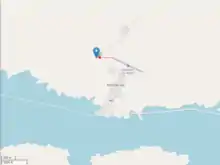West Wind Aviation Flight 280
West Wind Aviation Flight 280 was a domestic passenger flight from Fond-du-Lac Airport to Stony Rapids Airport, Canada. The aircraft was an ATR 42-320 registered C-GWEA. On 13 December 2017, shortly after taking off from Fond-du-Lac, the ATR-42 lost altitude and hit the ground. All 25 passengers and crew initially survived the crash, but one passenger later died of his injuries in hospital. Investigation on the cause of the crash is still ongoing.
.jpg.webp) The crashed aircraft in 2009 while still in service with Fly540 | |
| Accident | |
|---|---|
| Date | 13 December 2017 |
| Summary | Crashed shortly after take-off; under investigation |
| Site | Fond-du-Lac, Saskatchewan, Canada 59.3368°N 107.2019°W |
| Aircraft | |
| Aircraft type | ATR 42-320 |
| Operator | West Wind Aviation |
| ICAO flight No. | WEW280 |
| Call sign | West Wind 280 |
| Registration | C-GWEA |
| Flight origin | Fond-du-Lac Airport, Fond-du-Lac, Saskatchewan, Canada |
| Destination | Stony Rapids Airport, Stony Rapids, Saskatchewan, Canada |
| Occupants | 25 |
| Passengers | 22 |
| Crew | 3 |
| Fatalities | 1 |
| Injuries | 24 |
| Survivors | 24 |
Aircraft
The aircraft was an ATR 42-320 registered C-GWEA and was equipped with two PW121 turboprop engines produced by Pratt & Whitney Canada.[1] The aircraft entered service in 1991 with Aviación del Noroeste, and was later transferred to a few operators, including Zambia Airways, United Nations, and Fly540. The aircraft joined the fleet of West Wind Aviation in 2012, and was aged 26.8 years at the time of the crash.[2] This type of aircraft has previously been associated with accidents due to ice forming on the wing in freezing weather. The most notable accident was American Eagle Flight 4184. Experts say that changes in procedures and aircraft systems have solved the problem.[3]
Accident

The accident took place on December 13, 2017. According to the weather forecast, it was cloudy with temperature as low as −19 °C (−2 °F).[4] At 6:15 pm local time, the aircraft began its takeoff roll from Fond-du-Lac Airport. During the initial climb stage, the aircraft lost altitude and impacted the terrain 600 metres (2,000 ft) away from the runway. There was an 800 foot (240 m) trail of debris. The aircraft finally came to a stop in the upright position yet tilted to the right. The most serious damage was on the left side of the airframe, where it ruptured near seats Row 3.[5] There was no explosion nor fires at the crash site, but fuel leaks were found by nearby residents who rushed over for rescue work.[4]
Rescue work was immediately launched by local residents. Some of them followed the screams and rushed to the crash site near the airport, helping people to get out.[4] The passengers also struggled to save themselves. Four of them tried for half an hour and managed to open the emergency exit door.[6] Other passengers left the aircraft and guided local residents to the crash site.[7] People sent out alerts through Facebook, calling for more resources, and in 10–20 minutes more people arrived with blankets. Within a few hours, all aircraft occupants were rescued. Royal Canadian Mounted Police finally took over the crash site.[7]
There were 25 people on board, including 22 passengers, 2 pilots and 1 flight attendant. Nobody was killed initially, but six passengers and one crew member received serious injuries, at least five of whom were transported to hospital via air ambulance. The other 18 aircraft occupants received minor injuries.[4][3][8] A 19-year-old passenger died on 25 December 2017 as a result of his injuries.[9]
Investigation
Transportation Safety Board of Canada launched the investigation.[4] BEA, ATR (aircraft manufacturer), Pratt & Whitney Canada (engine manufacturer), and Transport Canada also sent representatives to the site. Flight recorders were recovered and sent to the lab in Ottawa.[8][10]
West Wind Aviation's air operator certificate was suspended on 22 December 2017 by Transport Canada, due to deficiencies in the company's operational control system.[11]
They were allowed to fly again on May 8, 2018, after Transport Canada said West Wind had addressed the regulator's concerns about deficiencies in the company's operational control system.[12]
References
- Accident description at the Aviation Safety Network
- "C-GWEA West Wind Aviation ATR 42". Planespotters.net. 2017-08-04.
- "Aviation experts defend safety record of type of plane used in Saskatchewan crash". CBC News. 2017-12-15.
- Guy Quenneville (2017-12-13). "All 25 passengers on crashed Saskatchewan flight 'accounted for' but some require air ambulance, RCMP say". CBC News.
- Hradecky, Simon (2017-12-14). "Accident: West Wind AT42 at Fond-du-Lac on Dec 13th 2017, impacted terrain shortly after takeoff". The Aviation Herald.
- Micki Cowan (2017-12-15). "Plane crash survivors took half an hour to pry open emergency exit". CBC News.
- Guy Quenneville (2017-12-15). "What happened on the ground after the Fond-du-Lac plane crashed, as told by 3 rescuers". CBC News.
- "Aviation Investigation A17C0146". Transportation Safety Board of Canada. 2017-12-15.
- "Passenger in Fond-du-Lac plane crash has died, family says". CBC News. 2017-12-27.
- "New information emerges about the near-fatal northern Sask. crash". CBC News. 2017-12-16.
- "Canada regulator suspends West Wind Aviation's license after crash". Reuters. 2017-12-23. Retrieved 2018-04-02.
- "West Wind Aviation cleared to fly again by Transport Canada after Fond-du-Lac crash". CBC News. 2018-05-08. Retrieved 2018-04-02.